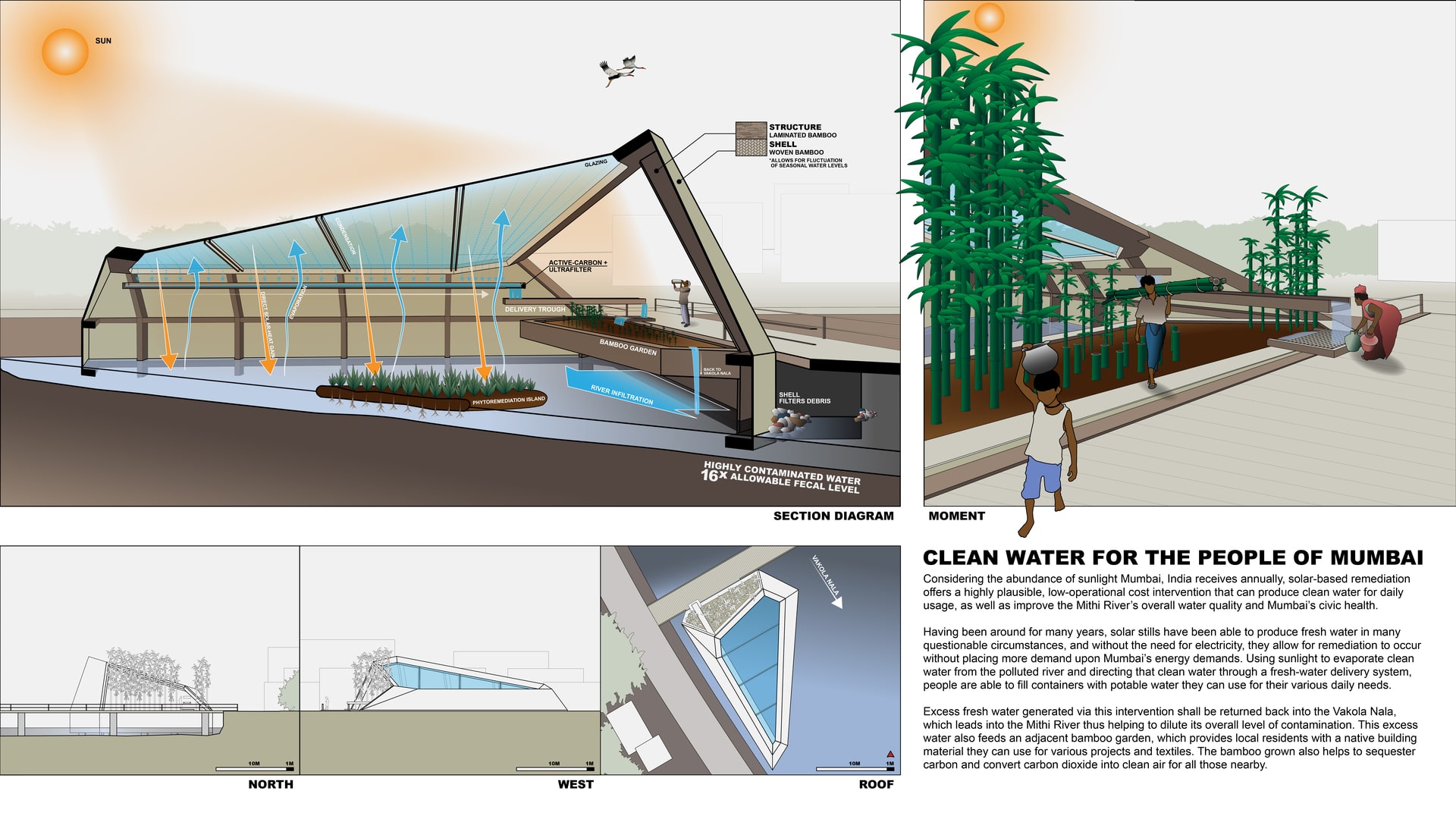Project Description
CLEAN WATER FOR THE PEOPLE OF MUMBAI Nicholas Ashton Morse // Daylight Investigations // Summer 2020 With nations constantly evolving and pushing for the edge of modernity, poorly managed industrialization and civic inequalities have led to the neglect of our everyday environments. Mumbai, India is such a place that has found its everyday necessities like fresh air and clean water being compromised. 60% of Mumbai’s population lives in inadequate housing without sufficient infrastructure for proper waste management, which has led to the Mithi River and its tributaries being heavily polluted to the point of turning their waters black. Governing bodies and numerous locals of Mumbai have realized the need to engage this issue and have implemented various tactics, such as shutting down industrial waste dumping, collecting trash from the waterways, and building controversial concrete retaining walls along the water’s edge; but at this point, the river resurrection plan is considered poorly implemented and far from completion. One way of addressing Mumbai’s need for clean water is through the use small-scale remedial solutions that require little, to no energy from the grid to operate. Considering the abundance of sunlight India receives annually, solar-based remediation offers a highly plausible, low-operational cost intervention that can produce clean water for daily usage, as well as improve the Mithi River’s overall water quality and Mumbai’s civic health. Having been around for many years, solar stills have been able to produce fresh water in many questionable circumstances, and without the need for electricity, they allow for remediation to occur without further burdening Mumbai’s energy needs. Using sunlight to evaporate clean water from the polluted river and directing that clean water to a fresh-water delivery system, people are able to fill containers with potable water they can use at home for consumption and cooking. Excess fresh water produced shall be returned back into the Vakola Nala, which leads into the Mithi River thus helping to dilute its overall level of contamination. This excess water is also directed to an adjacent garden, which grows bamboo for local residents to utilize as building materials and textiles. Continuously growing bamboo, which is reliant upon solar access, also helps to sequester carbon and convert carbon dioxide into clean air for all those nearby. This intervention is constructed from locally resourced bamboo. Laminated bamboo is used to create its structural framework and woven bamboo strips are used to clad its shell. Optimally angled glazing allows direct solar-heat gain to occur within a main chamber used to slow the movement of water. This slowing chamber allows water enough time to absorb enough solar radiation to evaporate. As the water becomes gaseous, it moves vertically upwards due to stratification, detaching itself from various harmful contaminants. As it moves upward, the water vapor collects upon the bottom side of the glazing where it condenses. After enough condensation is amassed, gravity pulls the clean water down the sloped glazing to a collection trough, which directs it to the delivery trough. To pass into the delivery trough, the fresh water must fall through an active carbon filter, which removes unwanted odors and flavors, and an ultrafilter, which removes 99.9% of viruses, bacteria, parasites, and microplastics. At this filtration point, water flow is throttled, and excess water produced at a rate faster than what can be filtered is released back into the Vakola Nala. Water that reaches the delivery trough is directed to a delivery point where people can fill their personal containers. Excess water from the delivery trough shall be directed into an adjacent bamboo garden that functions as the chamber’s northern cladding. The glazed-roof chamber performs as a greenhouse aiding the bamboo’s growth. Beyond being a material for nearby residents to utilize, the bamboo grown within this garden also serves as material to maintain and repair this intervention as it ages. To further assist with water treatment, a phytoremediation island is placed within the chamber, as well. Knowing that this intervention only tackles a small fraction of the much-needed remediation of Mumbai’s water, it lends itself to stir conscientious design implementations that together hold the potential to greatly impact the quality of life for so many. Using time-tested, low-energy techniques that tap into natural resources, such as the abundant sunlight of India, to overlap and provide higher levels of performativity capable of satiating various civic needs is a must; and solar-based remediation techniques are readily available, versatile, and impactful.
